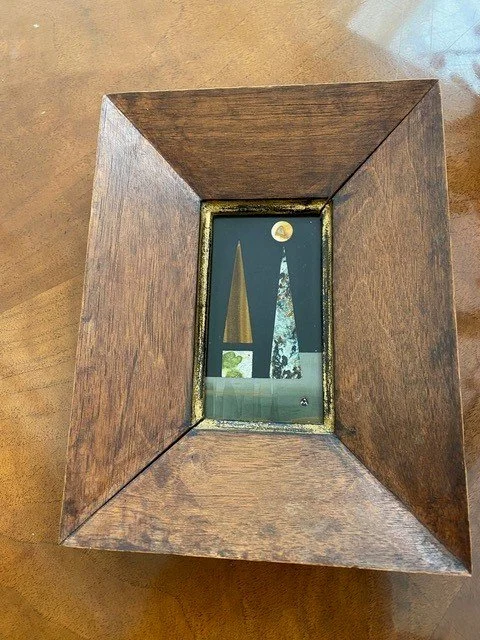Richard Blow created some exquisite small mosaics.
Richard’s son David gifted this little 2-inch by 4-inch Montici geometric (MSID “Pyramids, Ball, Block #7”) to our family friend, attorney/art collector Arthur Anderson, in 1983. Arthur had traveled to Florence at David's request to help settle Richard's estate.
Tiny mosaics can disappear on a wall unless handled creatively. In this case, an oversized walnut frame, with an inset, gilt border, picks up the colors of the left pyramid and the ball, pulling the whole piece together. The large frame catches your eye on a wall, and directs your attention into the artwork. We don’t know whether Richard or his workshop maestro Bruno Lastrucci came up with this frame design, but it’s an inspired solution to the challenge of spotlighting a small mosaic.
Our Society database includes seven, different variations of Richard’s popular “Pyramids, Ball and Block.” They tend to be affordable, falling mainly in the $1,000-$3,000 range. Richard started producing this iconic Montici design as early as 1952, based on an exhibition photograph we came across in the files of the Opificio in Florence. The smallest artwork of this design in our database measures a mere 2 x 3.25 inches; the largest is 10.5 x 7.75 inches. Richard experimented with a full palette of stone colors — crimson red, lapis blue, lemon yellow, wispy aurora green, bright orange; he even executed one employing nothing but alabaster white for the geometric shapes (with black onyx shadows). This work is currently for sale on our “Market Report” page.
Mahalo (Hawaiian for “thanks”) to Art Anderson for sending John this photo. One work closer to our goal of identifying all 1,500 Montici works Richard is estimated to have produced in his prolific career.
P.S. Arthur is best known for his decades-long, passionate collecting of artworks produced by the historic Woodstock Art Colony in upstate New York. Long before the iconic, Vietnam War-era, 1969 Woodstock rock concert, Woodstock was home to what is considered America’s first year-round arts colony, founded in 1902 and still thriving over 100 years later. Arthur recently donated his entire collection — some 1,500 objects by almost 200 artists — to the New York State Museum.
Check it out here: Woodstock Art Colony exhibit
